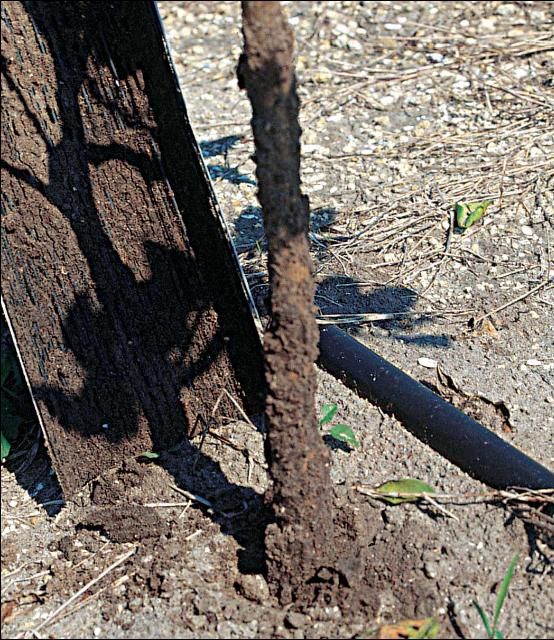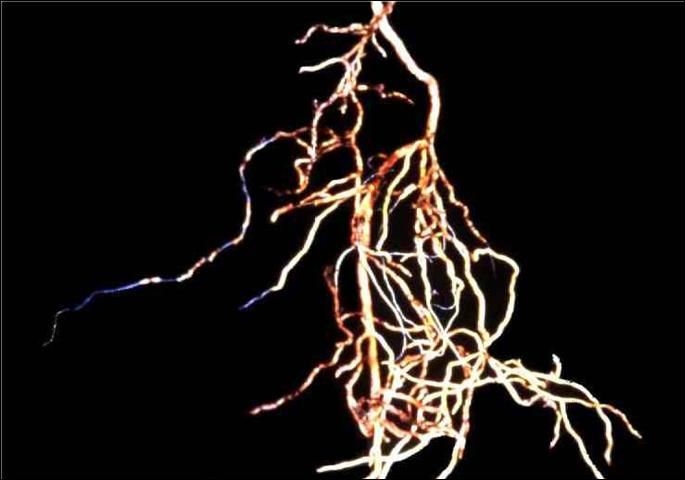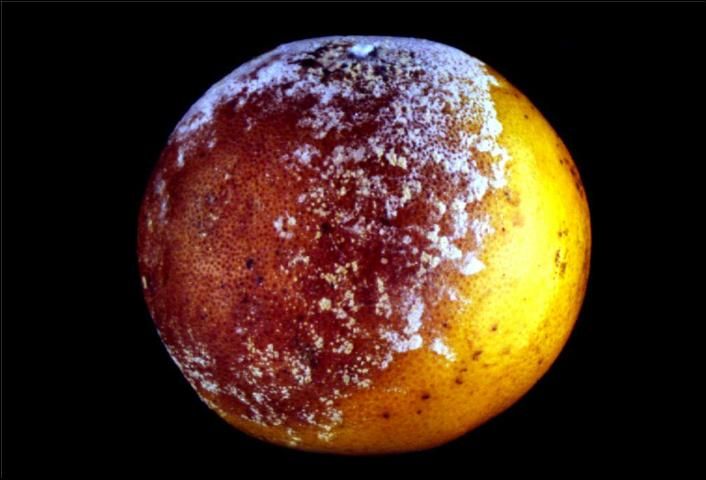Phytophthora species are important soil-borne fungal pathogens worldwide that attack the root systems, trunks, and fruit of citrus trees at any age. Historical reports from Florida indicated Phytophthora was a problem as early as 1876 on sweet orange seedlings. When roots or tree trunks are affected, the foliage turns yellow and exhibits poor growth, leaves drop, twigs die back, and fruit size and yield are reduced. As fungal infection of roots and bark progress, the above-ground symptoms increase in severity. Ultimately, trees may decline and die. These symptoms result from the inability of the tree's fibrous roots to take up nutrients and water from the soil, as well as blockage of movement to the tree's canopy via lateral roots and the trunk. The movement of photosynthates 'downward' is also impaired. The two main species of Phytophthora in Florida are P. nicotianae and P. palmivora. Populations of either Phytophthora spp. in the soil may increase by repeated infection of fibrous roots resulting in rapid reproduction under conditions of high moisture and warm temperatures (75°F-90°F).
Trunk Symptoms
When Phytophthora infects the trunk of the tree, the symptom is referred to as foot rot (Figure 1). Lesions usually occur on the bark at or above the bud union on susceptible scions and rarely extend far above the ground. If dead bark and scaling occur in the scaffold branches of a tree, the problem is more likely due to other diseases such as Rio Grande gummosis or Psorosis. Rootstocks including rough lemon, Cleopatra mandarin, and sweet orange are susceptible to highly susceptible to infection and will also exhibit similar symptoms below the bud union. Phytophthora enters through wounds or natural cracks in the bark. Upon infection of the bark, the fungus kills the cambium layer leading to death of the bark. These lesions may first appear as a gum-soaked area on the surface of the bark. Upon further lesion development, a brown discolored, necrotic area will be found under the bark. In some cases, the margin of the infected bark may crack open, break away from the surrounding healthy bark, and curl back to expose the wood surface below.
As the lesion develops on the trunk to greater than 1/2 of the trees circumference, the decline symptoms in the canopy become quite visible. In other cases, the decline may be restricted to only a portion of the tree canopy Lesions that continue to expand eventually girdle the entire circumference and result in tree death. If the affected area expands slowly, the tree's vigor and health progressively decline due to its inability to transport photosynthates downward. When the tree is partially girdled by foot rot, the foliage may become dull and chlorotic, with the mid- and main lateral veins of each leaf becoming yellow while the rest of the leaf remains nearly normal.

Credit: UF/IFAS CREC
To minimize the risk of foot rot, growers are advised to select resistant rootstocks like Carrizo citrange, Swingle citrumelo, and Volkamer lemon rather than less tolerant rootstocks like Cleopatra mandarin, rough lemon, and certain citrumelos. When selecting nursery trees, efforts should be made to plant only disease-free nursery stock and avoid injury to the tree trunk. Budding the tree high assures that the susceptible scion will be well above the soil line when the tree is planted at the appropriate planting depth. The opportunity for the fungus to be splashed from the soil onto the susceptible scion is also minimized.
Ants can cause a significant problem on young trees that are wrapped to inhibit sprouts or to protect the trunk from cold injury. The wraps provide an ideal site for colonies of ants to develop (Figure 2). The ants feed on the tree trunk injuring it and introducing Phytophthora with soil which infects and then girdles the trunk. Growers can also prune low hanging branches on young trees to reduce the humidity under the canopy and the persistence of moisture on the trunk. Proper irrigation scheduling and maintaining good soil drainage minimizes Phytophthora population build-up under excessively moist conditions. If signs of foot and root rot are present on young trees, fungicide applications may be prescribed to reduce further development of root rot and foot rot symptoms. (See Phytophthora Foot Rot and Root Rot in the Florida Citrus Pest Management Guide, SP-43, for details — https://edis.ifas.ufl.edu/CG009.)

Credit: UF/IFAS CREC
Root Symptoms
Fibrous root rot (Figure 3) is also a problem in some older citrus plantings and leads to decreased vigor and productivity of the tree but rarely kills the tree. Affected trees have thin canopies, twig dieback, and small fruit which reduce yields. When roots are infected, the outer root tissue (cortex) becomes soft, discolored, appears water soaked, and sloughs off from the root leaving only the white, threadlike root cylinder. Root rot is difficult to diagnose in the field because many factors may lead to fibrous root death including natural causes, drought, high salinity, nematodes, and root weevils.
Damage to the primary and secondary roots caused by Diaprepes root weevil larvae feeding can also provide entry points for Phytophthora spp. (Figure 1) to infect the structural root system. The inherent resistance of a given rootstock to Phytophthora spp. can be broken by weevil larvae, allowing even the most resistant rootstock to be infected and further damaged. (See Root Weevils in the Florida Citrus Pest Management Guide, SP-43, for details — https://edis.ifas.ufl.edu/CG006.)

Credit: UF/IFAS CREC
Fruit Symptoms
Brown rot of fruit is caused mostly by P. palmivora. When fruit is infected, it will have a leathery, olive-brown discoloration (Figure 4). Rind rot may develop when inoculum from fallen fruit on the soil surface is splashed by rain onto low-hanging fruit. Fruit infected with brown rot will have a characteristic rancid odor.

Credit: UF/IFAS CREC
Once established in the lower canopy, brown rot progresses higher in the tree canopy as inoculum is splashed from infected fruit to healthy fruit. Under humid conditions, the surface of infected fruit is covered by white mycelal growth, but the mycelium is no longer visible when the fruit dries. Brown rot is most often seen in Florida during late August through October, when color break of fruit occurs. Early cultivars are generally more susceptible than late season cultivars. Environmental conditions that favor the development of brown rot of citrus fruit are surface wetness for more than 12 hours for several days in succession and temperatures of 75°F–85°F. Application of Aliette and phosphite containing fungicides in July must occur before the disease outbreak and will protect fruit from infection for up to 3 months. After brown rot appearance, only copper fungicides are useful for controlling the production and spread of inoculum. (See Brown Rot of Fruit in the Florida Citrus Production Guide, SP-43, for details — https://edis.ifas.ufl.edu/CG022.)